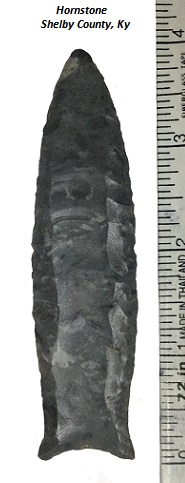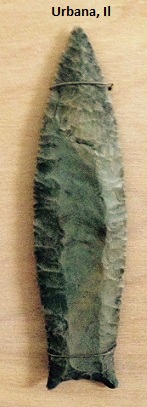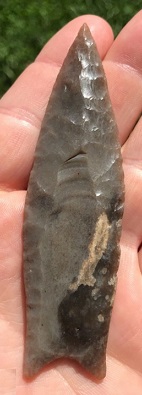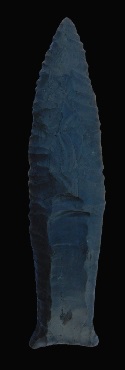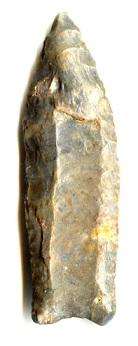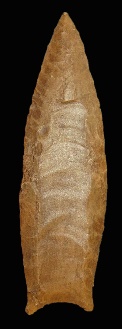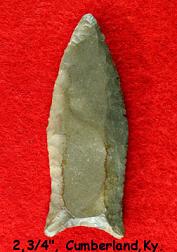Outline is Representative of Size and Shape:
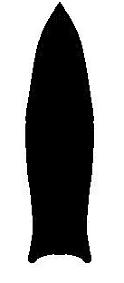
Name Details:
Identified By: Thomas N.M. Lewis
Named For: Cumberland Valley
Date Identified: 1954
Type Site: Multiple site in the Cumberland Valley of Tennessee and Kentucky
Identified By: Thomas N.M. Lewis
Named For: Cumberland Valley
Date Identified: 1954
Type Site: Multiple site in the Cumberland Valley of Tennessee and Kentucky
Point Validity:
Valid type
Lewis was a prominent anthropologist and professor at the University of Tennessee. He was instrumental in the formation of the Tennessee Archaeological Society and Tennessee Archaeologist journal where he served as editor. This type was named in a professional publication and has professional references. This is considered a valid type.
Lewis was a prominent anthropologist and professor at the University of Tennessee. He was instrumental in the formation of the Tennessee Archaeological Society and Tennessee Archaeologist journal where he served as editor. This type was named in a professional publication and has professional references. This is considered a valid type.
Cumberland Fluted
AKA: Ohio FlutedCluster: Cumberland Cluster
Description of Physical Characteristics and Flaking Pattern:
This is a medium to large fluted articulated lanceolate point. The cross section is flattened where the flute is present and elliptical above the flute. The point seems to have a median ridge before it is fluted as can be seen on the un-fluted portion of the tip, when the flute does not extend the full face. The blade has and outward recurvate shape due to a constrictive waist at the hafting area. The blade expands out from the waist forming articulates or ears. The base is concave and may have grinding that extends 1/3 or more the length of the point. The base has short flakes created by removal of the fluting platform using pressure flaking. Both faces have a long flake(s) or flute(s) that extends from 1/3 to the entire blade face. Un-fluted examples would not be considered a classic Cumberland point. This point has collateral flaking pattern.
Size Measurements:
Length - 35 to 105 mm Width - 15 to 25 mm Thickness - 3.5 to 8 mm Basal Width - 14 to 20 mm Basal Concavity - 2 to 6 mm
Length - 35 to 105 mm Width - 15 to 25 mm Thickness - 3.5 to 8 mm Basal Width - 14 to 20 mm Basal Concavity - 2 to 6 mm
Commonly Utilized Material:
Cherts, flints, jasper
Cherts, flints, jasper
Additional Comments:
These points are commonly found at sites in association with Clovis and Dalton points. However, they appear to be more closely related to the Folsom point based on the fluting techniques (Justice 1987).
This point has been found as far as southern Minnesota, but this is still controversial (W2).
In early literature, this point has been referred to as the Ohio Fluted point (Bell, 1958)
These points are commonly found at sites in association with Clovis and Dalton points. However, they appear to be more closely related to the Folsom point based on the fluting techniques (Justice 1987).
This point has been found as far as southern Minnesota, but this is still controversial (W2).
In early literature, this point has been referred to as the Ohio Fluted point (Bell, 1958)
Distribution: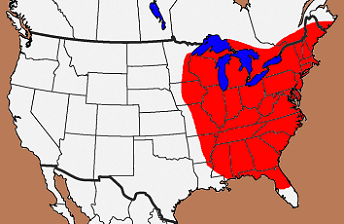

Distribution Comments:
This point is primarily found in the Cumberland River basin and through-out the Tennessee River basin. This point is found with less frequency into the Mississippi River basin and into the Ohio River basin. This point has been found into the Great Lakes region with rare frequency and have been reported into Minnesota by the University of Minnesota. This point has (Cumberland / Barnes) has been reported into Ontario (49 examples), Quebec (3 examples), Nova Scotia (144 examples), and Maine (6 examples) by the 2010 PIBDA. However, these points rarely reported in these areas and this overlaps with the similar Debert point. These points may represent variations of the Debert point.
This point is primarily found in the Cumberland River basin and through-out the Tennessee River basin. This point is found with less frequency into the Mississippi River basin and into the Ohio River basin. This point has been found into the Great Lakes region with rare frequency and have been reported into Minnesota by the University of Minnesota. This point has (Cumberland / Barnes) has been reported into Ontario (49 examples), Quebec (3 examples), Nova Scotia (144 examples), and Maine (6 examples) by the 2010 PIBDA. However, these points rarely reported in these areas and this overlaps with the similar Debert point. These points may represent variations of the Debert point.
Age / Periods:
Date: 11,000 - 9,000 B.P.
Cultural Period: Late Paleo
Glacial Period: Late Pleistocene to Early Holocene
Culture:
Date: 11,000 - 9,000 B.P.
Cultural Period: Late Paleo
Glacial Period: Late Pleistocene to Early Holocene
Culture:
Age Details:
Other points in this cluster / Related / Associated Points:
Cumberland Barnes, Beaver Lake, Clovis, Dalton
Cumberland Barnes, Beaver Lake, Clovis, Dalton

